What I learned hatching eggs naturally with a broody hen.

Each year I hatch around a thousand chicks a year across 22 breeds and I make use of both broody hens and incubators.
Hatching eggs naturally is simply using a hen in the motherly way to incubate the eggs until they hatch and then look after the chicks. The maternal instinct is strong with chickens, more so in some breeds than others.
It takes the same amount of time to hatch eggs naturally as it does in an artificial incubator. Below is a mother hen with a clutch of naturally reared chicks.
Below: A free range hen raising her brood of chicks naturally on pasture.
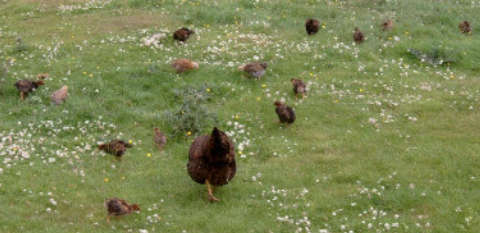
There are a great many advantages to the backyard flock keeper of using broody hens to raise young-stock. These could just as easily be duck or Guinea fowl eggs, they do not have to be chicken eggs although that is the norm.
Hen eggs normally hatch naturally after 21 days, though the larger eggs sometimes take a little longer and smaller bantam eggs can hatch from day 20.
And don't forget the "counting" starts 12 hours after the eggs are first put under, so really that is 21 and a half anyway! The hatch sometimes is completed with 24 hours, but can take 2 days.
Don't disturb the broody from day 18, if she wants to get off the nest she will but will probably sit tight and this is best for the chicks.
Reasons to use a broody hen to hatch eggs:
There are many arguments in favour of hatching eggs naturally under a hen.
- The are designed to raise a clutch of egg and most, but not all hens are good mothers.
- You can raise chicks without an incubator which tend to be expensive.
- There is less mess as the mother hen does all the work.
- It saves you time.
- It is cheaper.
- It is satisfying to watch.
- You can use the time when she is not laying eggs productively.
- The process of natural hatching normally has a better success rate.
- Chicks raised by a hen mature quicker and are better able to deal with life.
- They also learn to roost properly and fit into the flock better.
Reasons not to use a broody hen to hatch eggs:
- They can only raise a limited number of chicks.
- It requires planning.
- You need space.
- It can disrupt the flock dynamic.
Keep broody hens away from the rest of the flock:
It is best for the broody and her young family if you can have her sit somewhere quiet and undisturbed which will be convenient when the chicks have hatched, and it causes less problems if this is away from the usual nesting boxes, as the other hens may keep trying to lay in with her which causes squabbles and often results in broken eggs.
Also your broody may try to acquire any eggs laid within reach and you end up with a hen sitting on a huge and unmanageable quantity of eggs of differing ages. They also fluff up, growl and peck just like this one in the picture below.
Below: Broody hens often growl and raise their neck hackles defensively.
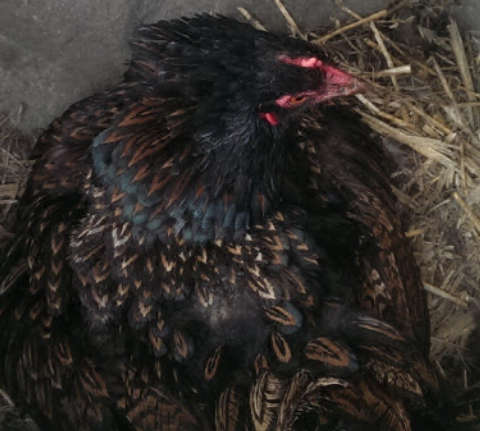
You could set up a broody coop in your hen run if it is large enough, or it can be somewhere else completely as long as it is fox proof. The first custom made broody coop I purchased was nicely situated on the lawn just outside my bedroom window and I was awoken around 2 am to find a fox had dug under and was pulling the broody out by her leg! A wire or wooden bottom to the coop solves this problem.
Traditionally people used to dig a "sod" of turf to make an artificial nest. It was turned over and arranged so was a dip in the centre to form a shallow cup for the eggs, but hay or straw is adequate, and the hen will arrange it to suit herself as she sits.
It was also traditional to set an odd number of eggs, i.e. 7, 11, 13. If you were superstitious that is.
First you need a broody hen:
First make sure she is properly broody and has settled well on eggs. These do not actually need to be eggs, golf balls or pottery eggs work just fine at this stage.
Some hens , particularly young ones or first time sitters can have a false start or two and take a bit of time to settle. This hen below is not broody - she has not covered the eggs and is just adding her egg to a nest with a few in already.
Below: This is not a broody hen, the eggs are uncovered.
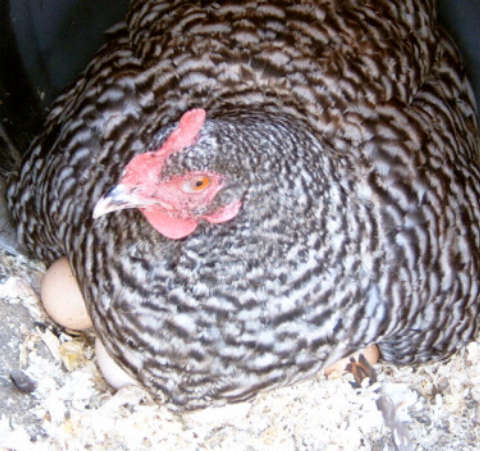
If she pecks you when you try to take the eggs from under her wear thick leather gardening gloves, and look away, rather than in her eye which hens find threatening and then they will often fly off squawking thereby damaging eggs.
Broody hen symptoms:
How to know if you have a broody hen:
- She just keeps sitting in the nest box even if you turf her out.
- Stopped perching at night.
- Stopped eating on a regular basis and just sits around all day and does massive broody poo's.
- Keeps pecking me when I try to collect the eggs.
- Has lost or has pulled the feathers off her breast to reveal the broody patch that helps keep the eggs warm.
- Her feathers are all fluffed up and standing on end and she is bad tempered.
- She will be making funny grumbling and clucking noises.
- Territorial over her nest box.
- Chicken walks around with wings dropped and tail spread.
- Growling sort of noise when I go by nest box.
- She has stopped laying.
If one of your chickens is doing any or all of the above its possible she is going to, or already has gone broody.
Below: Here is a bad tempered broody hen on a nest.
Hens are more likely to go broody than pullets, but both can go broody at any time, though warm weather and early spring on-wards into summer are the most likely times.
If you leave quantities of eggs in the nesting boxes it will tend to encourage broodiness as the birds think there are sufficient eggs to make a clutch, but even if all the eggs are collected regularly, once a bird has decided to go broody it will do so even if it means sitting on nothing for around 5 weeks or more.
There are various recommended methods of breaking a broody of wanting to sit, but in my experience once they have come back on lay they will simply lay enough eggs for another clutch then sit again. If you don't want to have broody hens this is the page for you - 7 ways to deal with a broody.
Why do chickens go broody?
A hen that is committed to hatching chicks is known as a broody.
This state is controlled by the temperature, day length, instinct, hormones and lighting conditions. Left to her own devices, a broody will lay a clutch, then stop laying and sit for 21 days or so until they hatch.
They don't choose to go broody so it isn't her fault and she didn't have any real choice in the matter and she definitely did not do it to annoy you or deprive you of eggs, even though it sometimes seems like it.
Can you encourage broody behaviour?
If you like the idea of naturally incubating your eggs, and you have the right breed of hen, then you will need a your hen to go broody and sit on the eggs.
You can not force a hen to become a broody, you can only help her on her way a little and see if she takes to it. It probably won't work with a hybrid. You should choose a heritage breed in her second year as these are most likely to become broody. There is a list of the broodiest hens below.
You can encourage a hen to go broody by leaving a clutch of artificial eggs in the nest for an extended period. Make sure it is a comfortable nest in a secluded place which is secure. It should also be warm and dry and draught free.
I have some that I can almost guarantee will go broody, I can even guess when in the year depending on the weather.
You can encourage a broody hen by keeping her enclosed in her own coop space and darkening a nesting box for her. I have a Barnevelder cross Silkie and all I have to do is put her in her own broody coop with a nest of eggs and she will sit in about 3 days.
If yours hasn't shown any signs of broodiness within a week to 10 days you should let her rejoin the flock as it probably is not going to work.
Prepare a nest for the broody hen:
If you have to move your broody from the nesting boxes, first arrange the area you want her sit in. It is best to do the moving after dusk but before complete darkness. Have the new nest ready with the eggs she has been sitting on and which are already warm.
Date the nest so you know they are going to hatch. Below is a broody Barnevelder hen. I often use cat boxes for the hens, they are easy to clean, come apart and can be moved anywhere in a flash. A happily sitting hen has a very contented look about her.
Below: I often use cat boxes as nest boxes for broody hens.

You can use a hot water bottle to warm the new nest for a few minutes to help her settle when you move her.
Select a cool, dark and draught free spot which is secure against predators. Prepare the nest and liberally dust with DE ( Diatomaceous Earth) to keep the parasites out.
Below: This is me dusting a nest with Diatomaceous Earth to deter parasites.

After you have transferred the eggs to her new nest, go quietly back and lift her off the nest, keeping her wings tight to her body to discourage fluttering which will stir her into action make her likely to jump straight off her new nest.
Place her quietly on the nest and cover the broody coop almost completely with an old blanket or something similar to almost exclude the light. Mostly you will find her on her new nest in the morning.
If all looks well, that night remove the old eggs and gently put the eggs you want to hatch up against her breast and she should soon tuck them in. Also make sure she can easily cover all her eggs, for if not, as she moves them around in the nest each egg will get chilled and warmed in turn, resulting in a completely lost clutch.
If, when using a broody you find she rejects an egg after a few days, bow to her superior knowledge and take it away. She knows it has stopped developing and doesn't want it to break and affect the other eggs.
Taking her off the nest every day:
Don't put her food and water within reach, but at the other end of the run if there is one attached. If she is sitting very tight and you think she isn't eating or drinking, after 2 or 3 days you may have to take her off the nest so she can have something to eat and drink, and defecate.
If you put her food and water within reach she may not get off the nest at all and will have to "poo" on the eggs. The bacteria in the poo after a couple of weeks at body temperature can result in the death of the chicks.
If you do need to lift her off the nest do so gently, and make sure she is not holding any eggs under her wings. If there has been an "accident" and she has broken an egg or messed in the nest try cleaning the eggs gently with wire wool or very fine sandpaper rather than washing them, as once an egg has had its protective bloom washed off bacteria can gain access, and may result in dead embryos.
If you really must wash them make sure the water is slightly warmer than the eggs, as if it is cooler the pores in the egg will close drawing any bacteria inwards. And if you can get hold of any proper egg washing disinfectant so much the better.
Below: Good natured hens sometimes share a nest but it is rare.
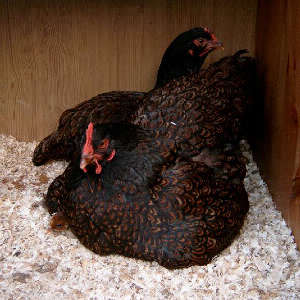
These two are sharing motherhood - not always the case. Hens with chicks are as likely to fight with each other as not.
Often, if I have taken a broody from the nest for food and exercise I throw her (obviously very lightly and gently) up into the air a little so she flutters down to land. The fluttering seems to encourage her to poo, and sitting hens do enormous and very smelly poos.
She should then run around a bit, have something to eat and drink, perhaps a dust bath and then go back to the nest herself. By the way, do make sure your broody has no mites or lice before she begins to sit, as this can prove so distressing to the broody she may give up.
If you have moved her from her chosen nesting spot, and she has the freedom to return don't be surprised if she returns to that empty nest and sits on nothing at all rather than returning to your beautifully prepared spot complete with its rapidly cooling clutch of beautiful eggs.
I knew an old farm worker who kept quite a few broodies each year, and their coops were in a row. Each hen had a curtain ring round its leg and they were tied with string to the coop to prevent them from fighting with each other and make sure they went back to the correct nest. The eggs can survive quite a while without heat, but it is much better if they do not have to.
Care of broodies:
You need to watch out for four things when using a hen to incubate eggs. Once they set on their eggs they will generally leave it only once a day to eat, drink, poop and maybe have a quick dust bath. All this happens in 20 to 30 minutes if she does not get up on her own you should intervene and take her gently of the nest.
Malnutrition:
Some broody hens are fanatical and won’t leave the nest to eat and drink and this can be a very real problem. A hen will die without food and relatively quickly.
Dehydration:
I once found a nest in a hedge where one of my free range hens had laid a clutch and sat so firmly she died before they hatched. Analysis of the embryo's showed it was about day 6 or 7 so she probably wasn't getting up to drink.
Parasites:
A sitting hen provides a lovely warm spot for all sorts of nasties and parasites. A good dusting of Diatomateous Earth before she settles will work wonders. Do the nest, box and surrounding area and even the hen if she will let you.
Predators:
Leaving hens sit on eggs where they choose will likely get them eaten by predators. Use a secure spot.
It has been estimated that a broody hen will decrease her nutritional intake by up to eighty percent! I can well believe it – the ladies look very ragged and tired after brooding.
If it is later in the year, a hen may go into the moult early and replace all of those worn out feathers
Which breeds of chickens make the best broody hens?
Some breeds are renowned for being broody birds. In my experiance the top 5 are:
- The Silkie
- Orpingtons
- Sussex
- Pekins
- Cochin
The Brahma needs an honourable mention.
Bantams show more of a trait to broodiness than large fowl. They can not cover as many eggs though. They also seem to be more careful mothers and dont step on the chicks as often.
It is important to remember that the trait of broodiness is a tendency that is more marked in some breeds than others and in some birds more than others of the same breed. I have some light Sussex that have never been broody and some that go more often.
I should probably mention a few breeds not to bother with:
Hybrids, Andalusians, Vorwerks and Lakenvelders should go in the don't expect much category of chicken motherhood. Modern hybrids are great egg layers and I have only ever had had 1 go broody on me and I currently have 37.
For an in depth guide into the care of broody chickens.
Can a broody hen adopt chicks?
A broody hen can adopt chicks that have been hatched under another chickens or in an incubator. It might not always succeed as some hens to not like to be interfered with during the sitting process.
This is another one of those many things in chicken keeping that can go either way. I would say I have roughly a 75% success rate with adoption.
It is a simple process.
I always do it late in the evening but before darkness. You need a hen that has been sat on eggs/fake eggs for a few days.
Enter the broodies space with the chicks in a warm dark box and give her a few minutes to get used to your presence .
Slip a warm hand under her and remove whatever she is sat on and begin slipping the chicks under her one at a time.
They will begin to peep and she will cluck back at them. When you have given her three or so stop and see what happens.
If she has been disturbed she will get up and wander around agitated and if she is accepting she will settle back in the nest and purr quietly.
If it goes wrong the chicks will start bleating and make the situation worse.
If it goes right there will be blissful peace and you can add the rest. I have done 17 to an Orpington but i would limit it to 10 or 12 max especially if it id the first time.
Watch for a few minutes to make sure none of the chicks wanders, it will help if they are well fed before the move.
Do not try with chicks older than 48 hours. the older the chicks the less likely it is to work.
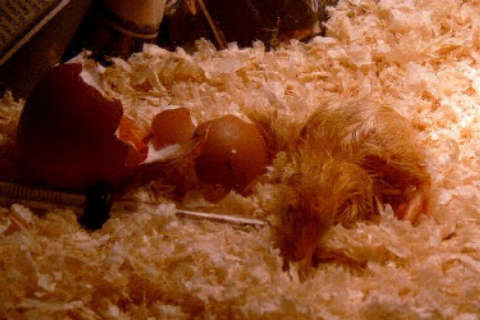
Above is a newly hatched chick from an incubator. Sometimes it is possible to get a hen to adopt chicks.
Newly hatched chicks can easily live for 2 days on the absorbed egg sac, but when they are due to hatch make sure within easy reach of the broody are chick crumbs, special small chick grit, and clean water in a container they cannot jump in and get wet, or even worst stuck.
A shallow tray such as fits under a flower pot with a few pebbles in will do. Don't forget to allow enough for the broody to eat as well, she will show them how to eat, and will eat the chick food with them.
If they are to be confined with no green food available then chickweed or salad leaves should be offered.
Good luck with your eggs. Watching a broody care for her chicks is one of the pleasures in life.
